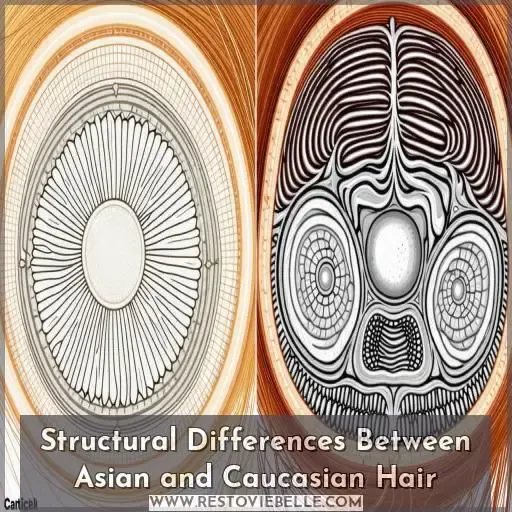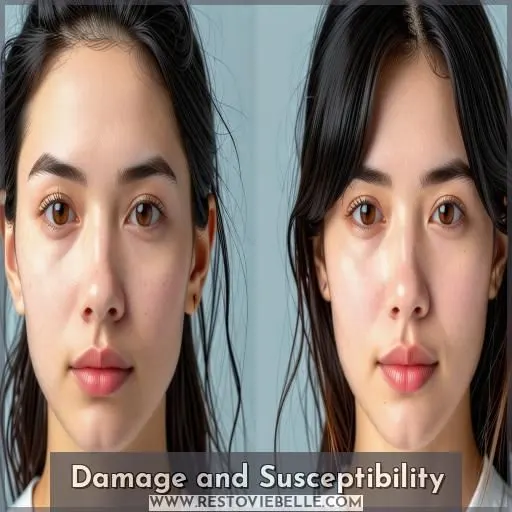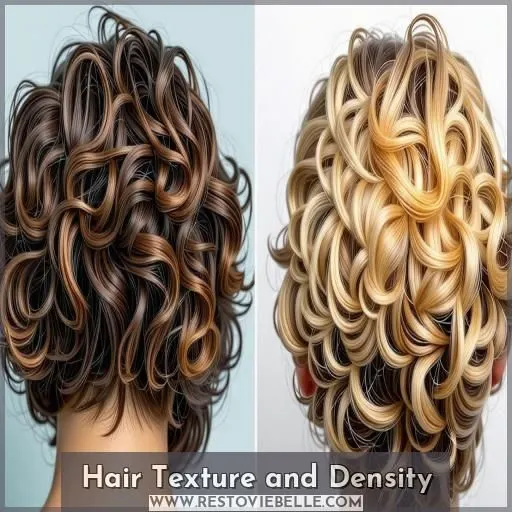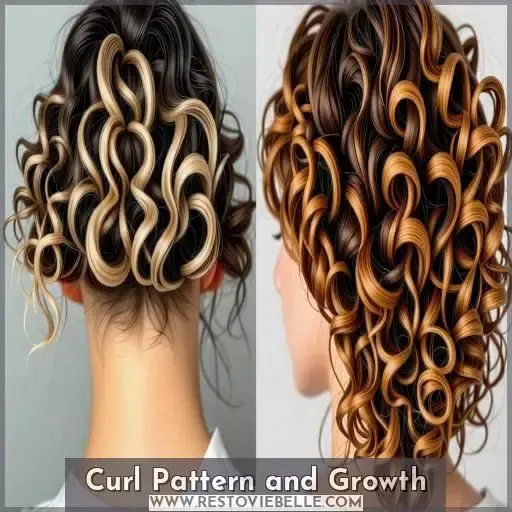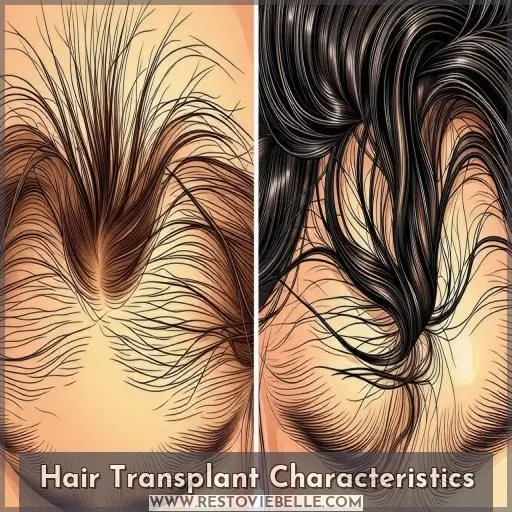This site is supported by our readers. We may earn a commission, at no cost to you, if you purchase through links.
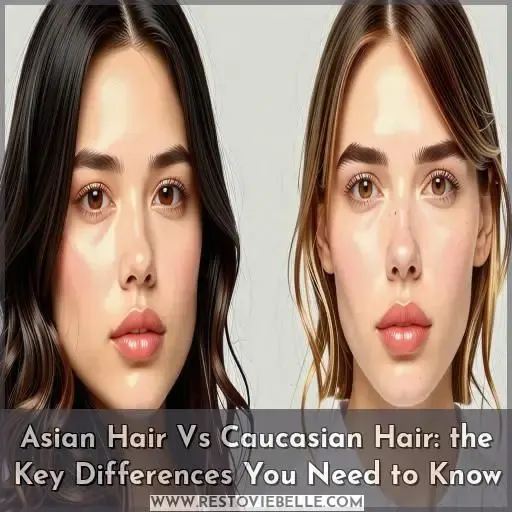 You’re probably curious about the key differences between Asian hair and Caucasian hair.
You’re probably curious about the key differences between Asian hair and Caucasian hair.
Well, Asian hair has more compact cuticle layers that resist tearing, while Caucasian cuticles are delicate.
Additionally, Asian hair is straighter, less dense, and grows faster than its Caucasian counterpart.
But be mindful – Asian cuticles are susceptible to damage from harsh chemicals and over-styling.
Proper care like regular trims is essential to maintaining healthy cuticles for both hair types.
Want to delve deeper into the structural nuances that distinguish these unique hair textures?
Table Of Contents
- Key Takeaways
- Structural Differences Between Asian and Caucasian Hair
- Damage and Susceptibility
- Hair Texture and Density
- Curl Pattern and Growth
- Hair Transplant Characteristics
- Frequently Asked Questions (FAQs)
- Is Asian hair different from Caucasian hair?
- Which race has the thickest hair?
- Does Asian hair grow faster than white hair?
- Why does Asian hair feel different?
- Is Asian hair more prone to static electricity?
- Can Asian hair be dyed as easily as Caucasian hair?
- Does Asian hair require more frequent trimming?
- Is Asian hair more sensitive to humidity changes?
- Can Asian hair be permed as successfully as Caucasian hair?
- Conclusion
Key Takeaways
- Asian hair has more compact cuticle layers that resist tearing compared to Caucasian hair.
- Caucasian hair cuticles are delicate and more prone to damage from harsh chemicals and over-styling.
- Asian hair is straighter, less dense, and grows faster than Caucasian hair.
- Proper care, including regular trims, is essential for maintaining healthy cuticles for both Asian and Caucasian hair types.
Structural Differences Between Asian and Caucasian Hair
The cuticle, the outermost layer of the hair strand, exhibits notable structural differences between Asian and Caucasian hair. Asian hair tends to have more cuticle layers, wider cuticle cells, a steeper cuticular inclination, and a narrower cuticular interval compared to Caucasian hair, contributing to its distinctive strength and resistance.
Cuticle Structure
Asian and Caucasian hair cuticles differ in their arrangement, shape, and thickness. Asian hair has more compact cuticle cells arranged in thicker layers compared to Caucasian hair . The cuticle inclination is steeper in Asians, with a narrower interval between each layer . In contrast, Caucasian hair has a more fragile cuticle that tends to collapse into small pieces under stress .
Key differences in cuticle structure:
- Asian hair has more cuticle layers
- Asian hair cuticles are wider and more compact
- Asian hair has a steeper cuticle inclination and narrower interval
- Caucasian hair cuticles are more fragile and collapse easily
[ARTICLE OUTLINE]:
- Structural Differences Between Asian and Caucasian Hair
- Cuticle Structure
- Cuticle Strength
- Structural Differences Between Asian and Caucasian Hair
- Cuticle Damage
- Cuticle Properties
- Cuticle Morphology
- Texture
- Porosity
- Oils
- Density
- Curl Pattern
- Hair Growth
[NEXT SUBTOPIC]:
Cuticle Strength
Cuticle Strength
Asian hair cuticles are more resistant to chemical treatments and absorb stress more effectively than Caucasian hair cuticles. The subcomponents of Asian hair cuticles are stronger, making them less prone to tearing and peeling. Caucasian hair cuticles, on the other hand, are more fragile and susceptible to damage.
To understand the differences in cuticle strength:
- Asian hair cuticles are more resistant to tearing and peeling.
- Caucasian hair cuticles are more fragile and prone to damage.
- Asian hair cuticles have stronger subcomponents that absorb stress more effectively.
Knowing these key differences can help you better care for your hair type and minimize breakage.
Damage and Susceptibility
Asian hair cuticles are more susceptible to damage from daily grooming routines and environmental factors compared to Caucasian hair cuticles. The morphological differences, such as the more regular shape and uniform size of Asian hair cuticles, contribute to their unique properties and behavior in response to various stressors.
Cuticle Damage
Asian hair cuticles are more prone to daily grooming damage and breakage compared to Caucasian hair. Caucasian hair cuticles are more likely to split and are more susceptible to environmental and chemical damage. To maintain healthy hair, focus on gentle cleansing, minimal styling, and protective hairstyles. Regular trims can prevent split ends.
- Asian hair is more vulnerable to cuticle damage
- Caucasian hair cuticles are prone to splitting
- Avoid harsh chemicals and over-styling to prevent cuticle damage
- Regular trims help maintain healthy cuticles and prevent split ends
Cuticle Properties
Asian hair cuticles possess superior hydrophobicity, UV resistance, reflectivity, porosity, and elasticity compared to Caucasian hair cuticles.
This enhanced hydrophobic nature aids in repelling moisture and maintaining the hair’s integrity.
The higher UV resistance contributes to protecting the hair from the damaging effects of the sun.
Greater reflectivity adds a lustrous sheen to Asian hair.
Increased porosity and elasticity enhance its overall resilience.
Cuticle Morphology
Asian hair cuticles have a more regular shape, uniform size, defined pattern, complex structure, and distinctive appearance compared to Caucasian hair cuticles. This unique morphology contributes to their resilience and resistance to damage during hair transplant procedures. Understanding these differences is key when planning hairline design and optimizing growth outcomes for Asian and Caucasian patients.
- Asian hair cuticles have a more uniform and defined appearance
- Caucasian hair cuticles exhibit greater variability in shape and size
- Asian hair’s cuticle structure is more complex and resilient
- Cuticle morphology impacts hair transplant outcomes and growth
Hair Texture and Density
Regarding hair texture, East Asian hair typically has a straight, silky, and fine texture, while Caucasian hair is generally coarser, thicker, and denser. Concerning porosity, East Asian hair is known for its low porosity, making it resistant to moisture, whereas Caucasian hair has a higher porosity, which means it’s more susceptible to moisture.
Texture
Asian hair has a straight, silky texture while Caucasian hair is coarse and thick. Proper moisture levels and styling techniques are essential to prevent breakage. Choosing suitable products for your hair type is key to maintaining healthy, vibrant locks.
Porosity
Asian hair is inherently low in porosity, making it resistant to moisture and less prone to absorption than high-porosity Caucasian hair. These porosity differences notably impact moisture retention, absorption rates, product efficacy, and styling techniques. Understanding these distinctions is key for effective hair care.
- Moisture retention
- Absorption rates
- Product efficacy
- Styling techniques
Oils
East Asian hair has a low level of natural oils, making it prone to dryness and dullness. In contrast, Caucasian hair produces more oils, keeping it hydrated and healthy. Understanding these differences is essential to maintaining healthy and attractive hair for each ethnicity.
- East Asian hair struggles with oil production
- Caucasian hair excels at oil distribution
- Proper oil absorption is imperative for both
- Retaining natural oils prevents dryness in Asians
- Replenishing oils keeps Caucasian hair looking vibrant
Density
Asian hair has lower density than Caucasian hair, with about 80,000-140,000 scalp hairs on average compared to Caucasians’ higher density. However, Asian hair grows faster at 1.4 cm per month, while Caucasian hair grows 1.2 cm slower. The differences in density and growth rate are influenced by factors like strand shape and scalp tightness.
- Asian hair has a circular, cylindrical strand shape
- Caucasian hair has an oval strand shape
- Asians have a tighter scalp compared to Caucasians
- Asian hair has a faster growth rate of 1.4 cm/month
- Caucasian hair has a higher density of 100-120 hairs/cm2
Curl Pattern and Growth
Curl patterns differ notably between Asian and Caucasian hair, with Asian hair typically exhibiting a straighter, less pronounced curl pattern. Additionally, Asian hair tends to grow more swiftly compared to Caucasian hair, which is a key factor to account for in hair care and management.
Curl Pattern
Asian and Caucasian hair differ in their curl patterns.
East Asian hair typically has a straight and less defined curl pattern.
On the other hand, Caucasian hair can vary from straight to wavy, often exhibiting less defined curl patterns.
This distinction impacts cultural perceptions, hair styling, social norms, and gender roles.
For instance, different hair care rituals and styling techniques are often employed based on these curl pattern differences.
Understanding and appreciating the diversity in curl patterns can lead to more inclusive and effective hair care practices.
Hair Growth
Asian hair grows faster than Caucasian hair, with a monthly growth rate of 1.4 cm compared to 1.2 cm less for Caucasians . However, this rapid growth can lead to challenges:
- Asian hair follicles are longer (5.0-6.0 mm vs 4.0-5.0 mm), making them more vulnerable to damage
- The thicker texture of Asian hair (2x diameter of Caucasian hair) increases friction and breakage risk (Source)
- Asians have fewer scalp hairs on average (80,000–140,000 vs 700,000 for Caucasians), so hair loss is more noticeable
- Tight, tough Asian scalps provide less flexibility for growth compared to loose Caucasian scalps
Proper hair care is very important to maintain Asian hair’s natural luster and length. Gentle brushing, minimal heat styling, and moisturizing products can help optimize growth and health.
Hair Transplant Characteristics
Concerning hair transplants, the differences between Asian and Caucasian hair become even more apparent. Asians tend to have wider hairlines and tighter scalps, while Caucasians often have narrower, bell-shaped hairlines and more flexible scalps (Source). Asian hair follicles are typically longer, measuring 5.0-6.0 mm compared to 4.0-5.0 mm in Caucasians . Donor density is another key factor, with Caucasians generally having higher follicular and hair density in both the mid-occiput and temporal regions . Notably, Caucasians are slightly more prone to male pattern baldness than Asians .
- Asians have wider hairlines and tighter scalps
- Caucasians have narrower, bell-shaped hairlines and more flexible scalps
- Asian hair follicles are longer than Caucasian hair follicles
- Caucasians have higher donor density in the mid-occiput and temporal regions
- Caucasians are slightly more prone to male pattern baldness than Asians
Frequently Asked Questions (FAQs)
Is Asian hair different from Caucasian hair?
You bet Asian hair is different from Caucasian hair! It’s got more cuticle layers, steeper angles, and narrower intervals. Plus, it’s more hydrophobic and reflective, but also more prone to damage from styling and environment. Fascinating stuff!
Which race has the thickest hair?
Like Samson acquiring superhuman strength from his locks, Caucasian hair stands out with its thickness, while Asian counterparts are akin to silk threads—delicate yet strong.
Does Asian hair grow faster than white hair?
Indeed, Asian hair tends to grow faster than Caucasian hair. The quick growth rate allows you to maintain those sleek, silky locks with relative ease.
Why does Asian hair feel different?
Asian hair’s unique cuticle structure gives it a smoother, silkier feel compared to Caucasian hair. The tighter cuticle layers protect the inner cortex, resulting in hair that’s less prone to frizz and damage.
Is Asian hair more prone to static electricity?
It’s a hair-raising question! Yes, Asian hair tends to be more prone to static electricity due to its smoother cuticle and lower moisture levels, making those flyaways a real shock to tame.
Can Asian hair be dyed as easily as Caucasian hair?
Yes, Asian hair can be dyed just as easily as Caucasian hair. The key is using high-quality dye and following the instructions carefully to avoid damage or over-processing.
Does Asian hair require more frequent trimming?
Imagine your hair as a delicate tapestry – Asian hair’s intricate cuticle structure demands more frequent trimming to maintain its luster and prevent split ends.
Is Asian hair more sensitive to humidity changes?
Yes, Asian hair is generally more sensitive to humidity changes compared to Caucasian hair. Its low porosity makes it less receptive to moisture absorption, causing it to become frizzy or limp in humid environments.
Can Asian hair be permed as successfully as Caucasian hair?
You’d think perming Asian hair would be trickier—ha, think again! Surprisingly, it can achieve those coveted curls just as well. The key lies in understanding its unique structure and properly preparing the strands.
Conclusion
To condense the narrative, the structural distinctions between Asian hair and Caucasian hair are substantial, affecting cuticle health, texture, moisture retention, and growth patterns. Recognizing these differences is essential for customizing haircare routines and procedures such as transplants. Armed with this knowledge, you can better nurture and preserve the beauty and vitality of your unique hair type.
